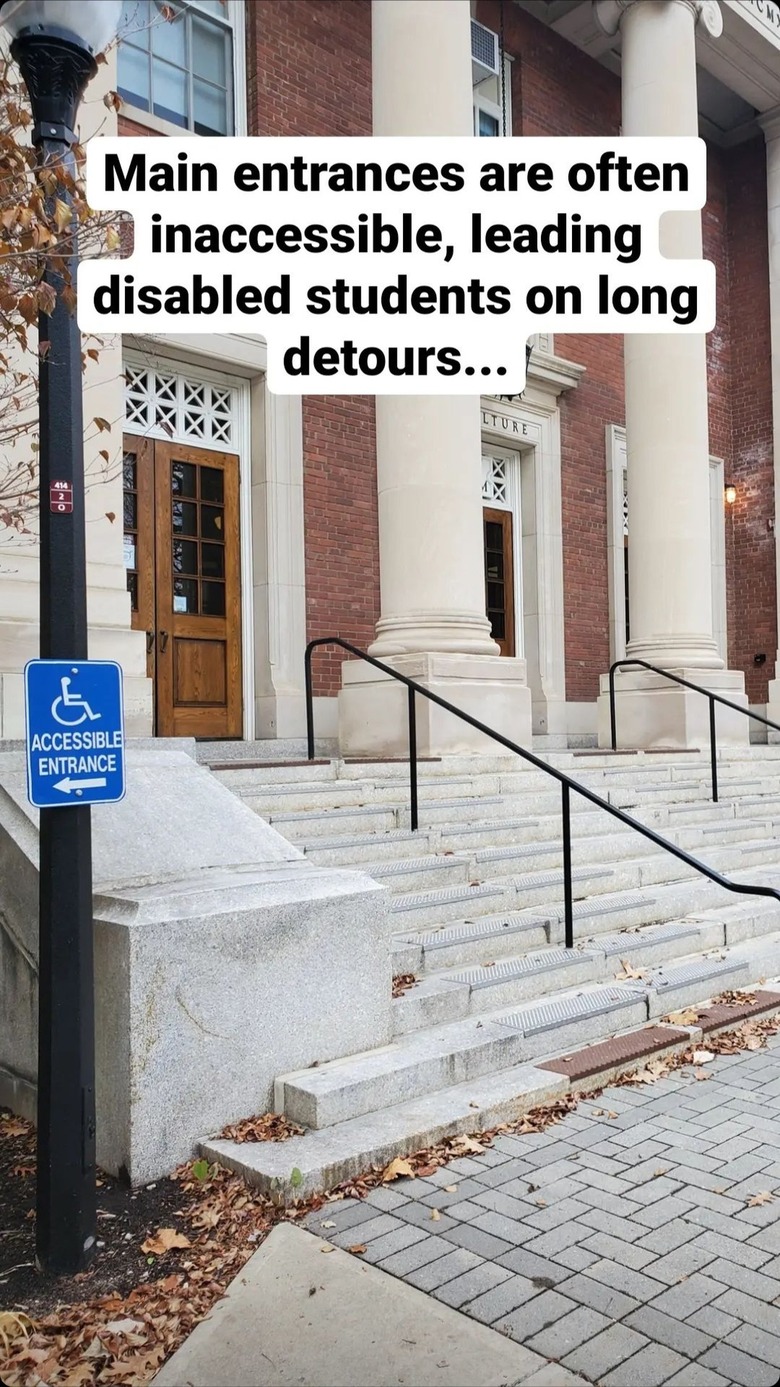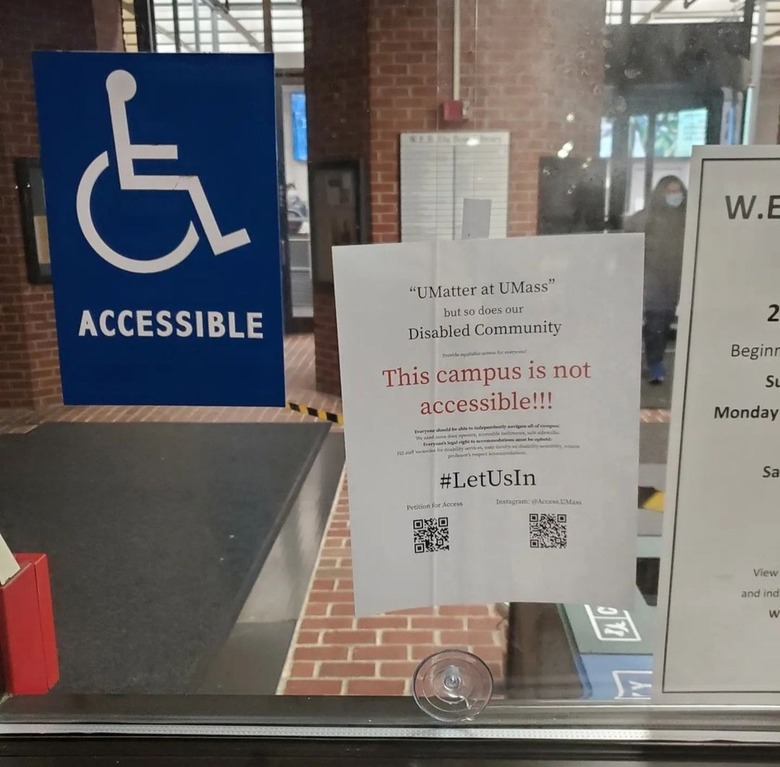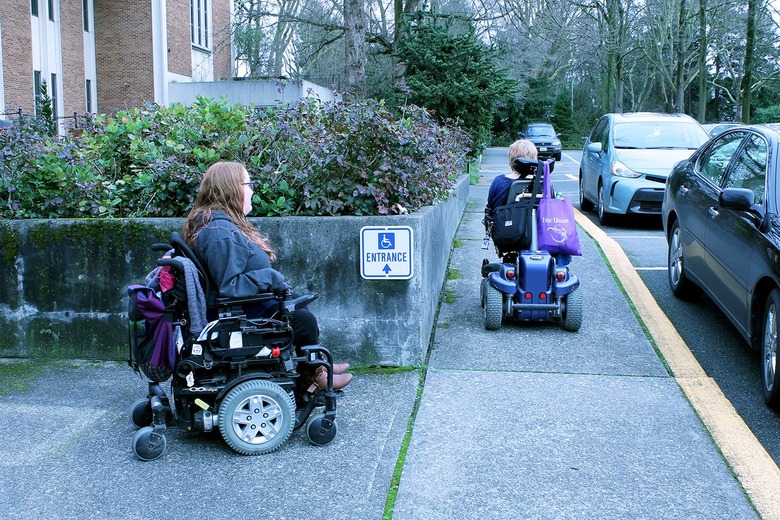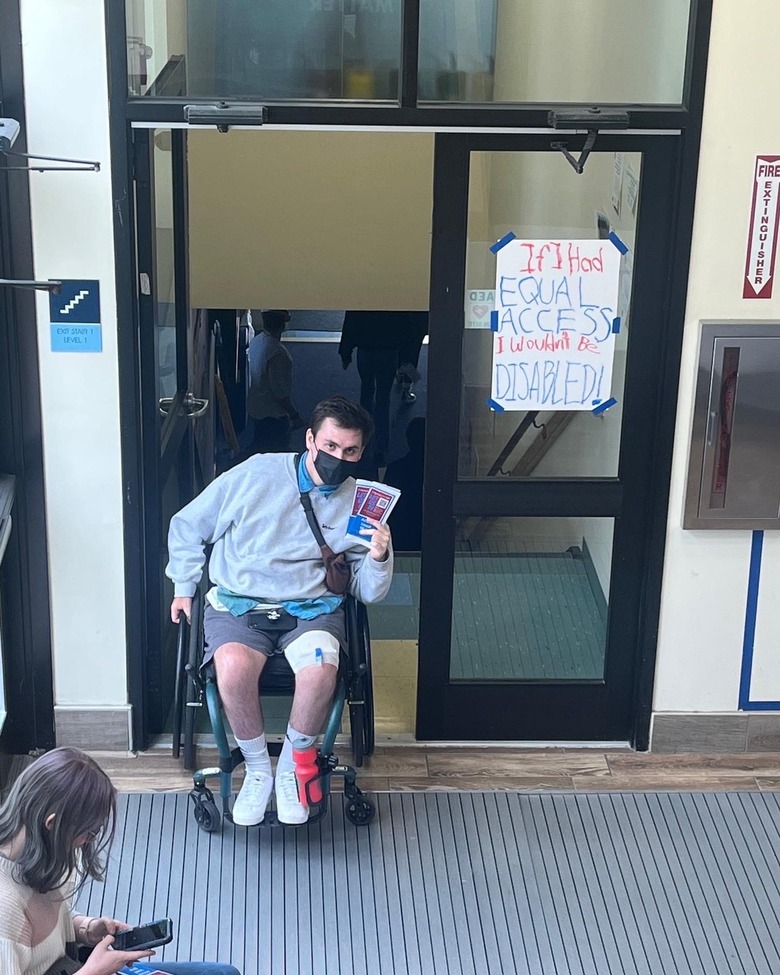College Campus Accessibility Shouldn't Fall On Students With Disabilities
When André, an undergraduate student at University of Massachusetts Amherst, developed a mobility impairment, he quickly realized that one of his classes was scheduled to be held in a classroom that was located up a large flight of stairs with no other access point. André (declined to give last name) had to contact the college and have the class moved to another room that would be accessible to him as a wheelchair user. This new classroom was also farther away and inconvenienced other students in the class.
"Advocating for yourself takes a lot of energy," André — who became involved with Access UMass, a disabled student-run group that advocates for improvements to accessibility on campus — tells Hunker. The group started to spread awareness, but grew tremendously when they began publishing TikTok videos pointing out specific access issues at UMass. "The burden of advocating for yourself falls to the disabled students so frequently."
College campuses have improved significantly in the years since the Americans with Disabilities Act (ADA) was passed into law in 1991. Almost 20% of undergraduate students have a self-identified disability according to a 2016 survey conducted by the National Center for Education Statistics, and 90% of colleges and universities report that they have enrolled disabled students according to a 2011 survey also by the NCES. These figures might be even higher when you take into account students who are not yet diagnosed or who don't register their disability with their college or university.
"The burden of advocating for yourself falls to the disabled students so frequently." — André
"It seems as though most campuses do better than they used to at making buildings accessible," says Sheryl Burgstahler, director of accessible technology and the Disabilities, Opportunities, Internetworking, and Technology (DO-IT) Center at the University of Washington in Seattle, Washington.
There are still significant barriers, however, and that's mostly due to the fact that college campuses are essentially like miniature cities and many campuses have a number of older buildings that were designed and built before accessibility standards were in place. "A university might build two or four new buildings in a time frame, but they still have ninety existing buildings," says Karen L. Braitmayer, fellow of the American Institute of Architects and principal at Studio Pacifica, a firm of architects and accessibility experts that focuses on consulting for accessible architecture and design projects. "This is not a clean sweep where, all of a sudden, the whole campus is accessible."
While newer buildings might be ADA compliant, that doesn't necessarily mean they're genuinely accessible to disabled students. André says that at UMass Amherst, new and newly renovated buildings are always ADA compliant but are often missing accessibility features that would make them usable to disabled students. Worcester Dining Hall, for instance, was recently renovated, but André can't go there because there are no tables accessible to wheelchair users. A lack of full accessibility leads to unintended segregation; André says he and most of his disabled friends all live in the same dorm, Brett Hall, because it's one of the only reliably accessible dorm buildings and was renovated specifically for wheelchair and other mobility aid users. They all dine at Franklin Dining Hall for the same reason, because an accessible table was added to the dining hall at the request of one of his friends.
"It's because we were excluded from other spaces on campus and forced into these accessible spaces." — André
"A lot of us aren't eating at the same table and living in the same dorm because we're all one big happy friend group," he says. "It's because we were excluded from other spaces on campus and forced into these accessible spaces."
Attitudes surrounding accessibility are also part of the equation. Both Braitmayer and Burgstahler advocate for universal design, which is a design principle that makes buildings, products, or environments accessible to all people. "I think universal design is a core value for us in terms of trying to find solutions that support all of the needs of all types of disabilities," says Braitmayer. Universal design even goes beyond disability and is about making spaces usable for everyone. Braitmayer points out how an automatic door opener may be designed with mobility aid users in mind, but it is also beneficial for a student who is carrying a lot of bags. "Many of these [accessibility] solutions support lots of different people; to us, that's the universal design approach."
In design of campus buildings and infrastructure, accessibility is often an afterthought if it isn't left out entirely. Many designers and architects aren't working with universal design in mind. Braitmayer's firm Studio Pacifica works with such people to ensure that college campuses and other projects have the highest level of accessibility given the constraints of the project. On one university campus that is extremely hilly with many steep contours, Braitmayer's team strongly encouraged the use of elevators in new buildings to serve as a sort of 'hill climb' where students could go into a building, use the elevator, and come out on the other side of the hill. Those elevators then need to also be accessible to students 24/7 so that they can use them to get around the hills on campus.
"Many of these [accessibility] solutions support lots of different people; to us, that's the universal design approach." — Karen L. Braitmayer
In Burgstahler's experience, many people designing these facilities are still viewing accessibility from an accommodations perspective — rather than a universal design perspective. To switch the way they think, universal design must be incorporated from the beginning. At the University of Washington, students reported accessibility issues in chemistry and science labs, such as not being able to get under a table as a wheelchair user. One change campuses can make, Burgstahler says, is including disabled students in the planning and consultation process for new spaces on campus.
When the University of Washington was designing a new science lab, she says they recruited about six disabled students to participate as paid consultants. These students reviewed the design plans and physically toured the facility as it was being built so they could point out areas where accessibility might be minimal or missing altogether. One of the students mentioned that an automatic door opener was too close to the door for a wheelchair user to effectively use, and another showed how the architects might re-orient the presentation screen so that more people can view it.
Architects and designers are often worried that accessibility improvements will be too challenging or expensive to complete, which isn't always accurate. "The architect said after they left, they were impressed with how simple the students' ideas were," says Burgstahler.
Accessibility doesn't have to be a burden for college campuses to implement, and it doesn't have to rest on the shoulders of disabled students and staff to advocate for their needs. "Accessibility can never be reactive," says Nick D. Shelley, Lasell University class of 2022 graduate and founder of Access Lasell, a chapter of Campus Access Network (CAN). Shelley explains that major accessibility concerns at Lasell include a lack of automatic door buttons, a sloped campus terrain, and improper signage, such as campus building signs with fake Braille. "If a school is reacting to someone who faced a barrier, that is not accessibility. Accessibility is preemptive or proactive, accessibility is someone never having faced an access barrier at all."
"Accessibility is preemptive or proactive, accessibility is someone never having faced an access barrier at all." — Nick D. Shelley
Shelley says that Lasell has been improving accessibility. The university created an Accessibility Improvement Team after Shelley created a video for his Honors Capstone component of the access barriers that he faces using a manual wheelchair on campus. There's still more to do, though, and Shelley says a lack of elevators at the Edwards Student Center is a major barrier because essential student services are available on each floor.
"I struggled so much getting to the top floor. The only 'accessible' entrance is up on a steep hill and there is only one parking spot up there, so I often could not get to the top floor," he explains. "This was extremely stressful because mandatory testing and health services are up there. In general, a campus like Lasell's with a hilly terrain needs to have proper accessibility features to get students and faculty up and down from the different levels."
At the end of the spring semester symposium this year, Shelley and others held a sit-in at the Edwards Student Center, occupying the staircase and politely asking everyone who walked by to take the accessible route, which meant they had to go down the street and around the block.
Many accessible entrances and routes are out of the way or around the back, and Burgstahler believes this is a problem. When a student uses an accessible entrance, they should feel welcome, she says. Designers should put thought into making the entrance attractive and convenient, not just accessible. "All of our students should feel welcome," she says. "If you always have to go in the back door or have to sit in the back row, that's not very welcome."
"All of our students should feel welcome. If you always have to go in the back door or have to sit in the back row, that's not very welcome." — Sheryl Burgstahler
More campuses need to prioritize universal design in their planning from the start, rather than viewing accessibility as simply following ADA compliance and making accommodations. When accessibility and universal design aren't central to the process from the start, you often end up with problems and wind up spending more money to do the same thing over and over, according to both Burgstahler and Braitmayer. "Accessibility isn't an extra step, it's a step that you left out. It's a step that you missed," says André.




